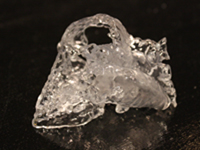 |
| Lights on Main Street, Salt Lake City |
The average American gains between 5 to 10 pounds during the holiday season and very seldom loses it during the rest of the year. Why do we gain so much weight during the holidays? How can people enjoy the holiday treats and parties and not gain the extra weight?
Dr. Keith Kantor, a leading nutritionist and author of the book, The Green Box League of Nutritious Justice, prepared the following list of tips that can help us avoid the dreaded weight creep of the holidays yet still enjoy the parties and treats.
- Cut down on saturated fat in creamy dressings by mixing in yogurt instead.
- For a wonderful flavor enhancer, sprinkle roasted vegetables with vinegar or citrus juice. Add it at the last minute so the flavor is at its strongest.
- Substitute chopped vegetables for some of the bread in your stuffing recipe, this will reduce the amount of carbohydrates in the stuffing therefore reducing the glycemic load.
- Don’t starve yourself the day of the party so you can fill up on food that evening. If you eat healthy normal meals throughout the day, you’re much less likely to overeat at the party.
- Remember: The point of holiday gatherings is to celebrate, not to eat. Mingle with friends and loved ones instead of hovering around the buffet table, grab a plate and walk away.
- Don’t load up at the buffet table. Keep portion sizes small by putting your snacks on a small plate instead of a large one and limiting your trips to the buffet.
- Prioritize your food choices, if you love sweet potato casserole take a serving of that but skip the stuffing if it is something that you don’t have to have.
- Present food in various locations all over your home to encourage activities and mingling not just eating.
- If you are going to drink alcohol alternate the beverages with water, this will keep you hydrated and may curb the increase in appetite from excessive alcohol.
- Make sure you include protein and vegetables as your appetizers and throughout the main meal. The protein from meat and fiber from the vegetables will keep you feeling full and avoid bingeing on excessive sugars and carbohydrates.
- When choosing cocktails, aim for non-calorie mixers like sparkling water with the juice or limes or lemons, rather than heavily sweetened juices or syrup based mixers.
- Remain active throughout the holidays, maintaining lean muscle mass from strength training and cardiovascular activity will help keep your metabolic rate (calories burned at rest) high to offset the extra calories from the holiday treats.
 |
| Dr. Keith Kantor |
About Dr. Keith Kantor
Dr. Kantor has been an advocate of natural food and healthy living for 27 years. In 1994 he was appointed CEO of Service Foods, Inc., the largest all natural food company of its kind in the United States.He has a Master Degree in Nutrition Science and a Master in Business Administration; Ph.D. graduate of Corllins University, Nutritional Science; Doctorate of Science graduate of Corllins University, Naturopathic Medicine. He also holds undergraduate degrees in Biology and Chemistry.
Dr. Kantor has been married for 37 years to Karen DeFiore Kantor. Karen is a registered nurse and is Director of Nursing for Services Foods, Green Box Foods, Blue Ribbon Foods and Southern Foods At Home. They have two children, Kimberly is the Director of Personal Training for Lifetime Fitness. She is a graduate of the University of Tennessee. Ryan received his undergraduate degree from Clemson University and his Master degree from the University of Georgia. He is currently employed with Bellomy Research in Winston-Salem, North Carolina as a research manager.
For more information go to http://www.drkeithkantor.com/









.jpg)





